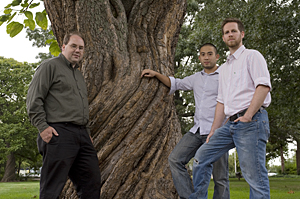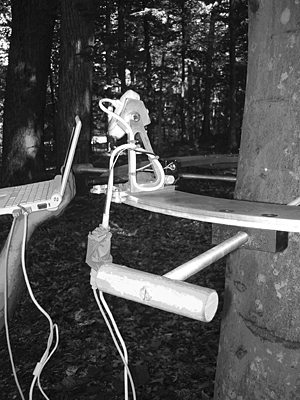
- Rozovsky wins prestigious NSF Early Career Award
- UD students meet alumni, experience 'closing bell' at NYSE
- Newark Police seek assistance in identifying suspects in robbery
- Rivlin says bipartisan budget action, stronger budget rules key to reversing debt
- Stink bugs shouldn't pose problem until late summer
- Gao to honor Placido Domingo in Washington performance
- Adopt-A-Highway project keeps Lewes road clean
- WVUD's Radiothon fundraiser runs April 1-10
- W.D. Snodgrass Symposium to honor Pulitzer winner
- New guide helps cancer patients manage symptoms
- UD in the News, March 25, 2011
- For the Record, March 25, 2011
- Public opinion expert discusses world views of U.S. in Global Agenda series
- Congressional delegation, dean laud Center for Community Research and Service program
- Center for Political Communication sets symposium on politics, entertainment
- Students work to raise funds, awareness of domestic violence
- Equestrian team wins regional championship in Western riding
- Markell, Harker stress importance of agriculture to Delaware's economy
- Carol A. Ammon MBA Case Competition winners announced
- Prof presents blood-clotting studies at Gordon Research Conference
- Sexual Assault Awareness Month events, programs announced
- Stay connected with Sea Grant, CEOE e-newsletter
- A message to UD regarding the tragedy in Japan
- More News >>
- March 31-May 14: REP stages Neil Simon's 'The Good Doctor'
- April 2: Newark plans annual 'wine and dine'
- April 5: Expert perspective on U.S. health care
- April 5: Comedian Ace Guillen to visit Scrounge
- April 6, May 4: School of Nursing sponsors research lecture series
- April 6-May 4: Confucius Institute presents Chinese Film Series on Wednesdays
- April 6: IPCC's Pachauri to discuss sustainable development in DENIN Dialogue Series
- April 7: 'WVUDstock' radiothon concert announced
- April 8: English Language Institute presents 'Arts in Translation'
- April 9: Green and Healthy Living Expo planned at The Bob
- April 9: Center for Political Communication to host Onion editor
- April 10: Alumni Easter Egg-stravaganza planned
- April 11: CDS session to focus on visual assistive technologies
- April 12: T.J. Stiles to speak at UDLA annual dinner
- April 15, 16: Annual UD push lawnmower tune-up scheduled
- April 15, 16: Master Players series presents iMusic 4, China Magpie
- April 15, 16: Delaware Symphony, UD chorus to perform Mahler work
- April 18: Former NFL Coach Bill Cowher featured in UD Speaks
- April 21-24: Sesame Street Live brings Elmo and friends to The Bob
- April 30: Save the date for Ag Day 2011 at UD
- April 30: Symposium to consider 'Frontiers at the Chemistry-Biology Interface'
- April 30-May 1: Relay for Life set at Delaware Field House
- May 4: Delaware Membrane Protein Symposium announced
- May 5: Northwestern University's Leon Keer to deliver Kerr lecture
- May 7: Women's volleyball team to host second annual Spring Fling
- Through May 3: SPPA announces speakers for 10th annual lecture series
- Through May 4: Global Agenda sees U.S. through others' eyes; World Bank president to speak
- Through May 4: 'Research on Race, Ethnicity, Culture' topic of series
- Through May 9: Black American Studies announces lecture series
- Through May 11: 'Challenges in Jewish Culture' lecture series announced
- Through May 11: Area Studies research featured in speaker series
- Through June 5: 'Andy Warhol: Behind the Camera' on view in Old College Gallery
- Through July 15: 'Bodyscapes' on view at Mechanical Hall Gallery
- More What's Happening >>
- UD calendar >>
- Middle States evaluation team on campus April 5
- Phipps named HR Liaison of the Quarter
- Senior wins iPad for participating in assessment study
- April 19: Procurement Services schedules information sessions
- UD Bookstore announces spring break hours
- HealthyU Wellness Program encourages employees to 'Step into Spring'
- April 8-29: Faculty roundtable series considers student engagement
- GRE is changing; learn more at April 15 info session
- April 30: UD Evening with Blue Rocks set for employees
- Morris Library to be open 24/7 during final exams
- More Campus FYI >>
12:04 p.m., Sept. 15, 2009----An invention by a University of Delaware doctoral student can provide information about the biological and physiological characteristics of trees that will yield valuable information for forest scientists and ecologists.
The LaserBarkTM, an automated instrument for the measurement of bark microrelief, was developed by John Van Stan, a Ph.D. candidate in geography, in conjunction with his adviser, associate professor Delphis Levia, and a mechanical engineering consultant, Matthew Jarvis.
The work grew out of Van Stan's master's thesis on the effects of bark microrelief on stemflow production. At the time, no instrument existed that could yield a high-resolution profile of bark microrelief, but Levia was aware of an earlier instrument developed by a botanist and lichenologist in the late 1960s that could be adapted and improved upon for Van Stan's work.
“I suggested to John that he develop a prototype instrument,” Levia says. “In typical fashion, John took the lead and developed the LaserBark. His thesis applied the newly developed technology to conduct pioneering work on stemflow production in relation to bark microrelief.”
The results of the thesis have been published in Ecohydrology, and a manuscript on the LaserBark will appear in IEEE Transactions on Instrumentation and Measurement later this year. Van Stan received an Outstanding Student Paper Award for the work at the 2009 American and Canadian Geophysical Unions' Joint Assembly in Toronto, Ontario, Canada. He will receive the award at the December 2009 AGU conference in San Francisco.
“The device can supply high-resolution measurements of bark microstructure, which can be used to examine lichen and bryophyte distribution and relate changes in bark microrelief to disease, for example, beech bark disease, or stem dehydration,” Van Stan says. “We hope that this international award will help employ the instrument more broadly, thereby providing the global scientific community an opportunity to further our understanding of the functional ecology of forest ecosystems.”
A provisional patent application claiming the device has been filed and is pending at the U.S. Patent Office, and the UD Office of Economic Innovation and Partnerships is seeking to commercialize it through patent licensing and associated collaborative research and development.
Right now, the LaserBark has only surface characterization capacity, so further work is needed to broaden its capabilities as well as its potential applications, which include nondestructive assessment of corrosion in pipes and other similar objects.
Although he is still a student, Van Stan has a good understanding of real-world scientific problems and solutions. As an undergraduate, he worked full-time at Tetratech NUS, Inc. in Newark, Del., to help pay for his education.
“John is a highly motivated self-disciplined scholar with a special interest in instrumentation and field methods,” says Levia. “I am confident that he will 'push the envelope' in developing new technologies to improve our understanding of water flux in wooded ecosystems.”
Van Stan plans to pursue a career in academia after he completes his Ph.D. in 2011.
For more information about the LaserBark, contact Brad Yops at (302) 831-0147 or [byops@udel.edu].
Article by Diane Kukich



